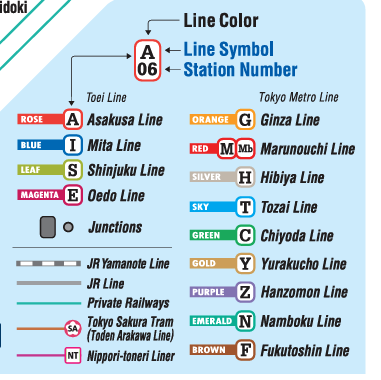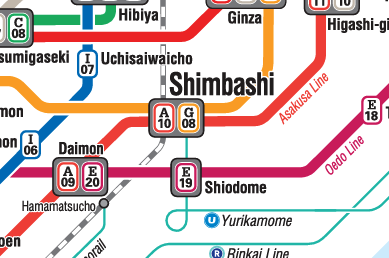
How to survive the Japanese public transport

One of the most common worries we all have is to dive into that mess of lines that is the map of the train/ metro of Tokyo. To be honest once you understand the tecnicalities on how it is set up you will find it so much easier to understand and navigate, it is not as different as going on the London tube or the Madrid metro.
First thing you should know to eas your mind is that now a days the maps display the stops in Japanese and in English which makes it so much easier, honestly, I think it would take us an eternity to figure out where we want to go if this wasn´t the case, although they all have also numbers so maybe we would have just guided ourselves by those.
But just as an anecdote, once when we arrived in a city where the bus stops names where only in Japanese. It took us some time to figure out which stop we where looking for by comparing the symbols, although then a very friendly employee confirmed our guess, you will find them at the main stations, they speak English and are very friendly and happy to help.
To get around we used always Google maps, but make sure you do not follow it blindly, as when we did that we ended up having a whole hiking adventure when the trip to the hotel had a much easier arriving route, although that is a story for an other time worth getting into more in ditail heheh. Moral of the story, remove the time filter and just focuse on the routes not the best routes at that certain time; 10 minutes wait could give you a much better route.
So let´s talk about how to get around Tokyo:
Fist of all you need to know it is a mixture of underground and over ground trains so I will be calling it throughout the post as Metro system, but it also has traisn that go over ground. It all works the same way.

The main difference that you will encounter in the Japanese system that I have not experienced in any other city is that to change line sometime you have to check out, walk for a bit and check in again. And other times you only have to change trains without checking out.
The reason for this is that, unlike other metro systems you may be used to, in Europe for example, is that the metro is not operated by the government. In Tokyo you have two main companies that own and operate the trains and work together to get the whole system going. You have the Toei Line that operates four lines and the Tokyo Metro Line that operates 9 different lines. As a general rule you only have to pass the gates when you change form a line owned by one company to a line owned by an other company. You also have the JR East company and 9 private rail companies that operate some lines that transfer to metro and JR lineas at many stations.

For example if you are at Shimbashi Station and you change from the Asakusa Line to the Ginza Line, you will have to pass the gates, swiping your Suica or Passmo card and do the same agian to enter the Ginza Line.
When moving around you need to have this 3 things in mind:
- The name of the line you need to catch.
- The direction you want to go to.
- The station you want to get to.
You can also guid yourself by the station number, but keep the following in mind: the number is according to the line not the actual station.
If we take the same example of the Shimbashi Station, it is the station number 10 for the Asakusa Line but the station number 08 for the Ginza Line.
Once you have that clear it will be much easier to move around and figure out which trains to use to get to your destination.
If you master the Tokyo metro system you will be able to use any other metro system in the country.
Long distance trains:
The most efficient way to travel around Japan is by train. There are different type of trains, which we learned about as we went around Japan. So let me give you a little run down on what options there are so you can be more prepared than we where.
When talking about trains there are 5 type of trains, even though they do the same rout, the further we go down the list the faster they go as they do less stops and the pricier they are, so make sure the train you are catching stops at the station you want to go to. If in doubt always ask the people at the desk they will help you catch the best option and you can rest assured they won´t try to cheat you because you are a tourist. We had that experience in a small station. The first day we thought he wanted to cheat us by making us buy the more expensive ticket, but turns out that the train coming was an Epress train. The next day we bought the express ticket, but he stoped us to give us back our money as the train coming was the Local one (cheaper one). So, no, here they won´t try to take you for a fool because you are a tourist.
Ok, lets talk trains.
The lower we go on the list the faster the trip and the less stops this train will make. The price difference starts being notable as from the Limited express train, the once before have a very low difference in price.
- Kakueki- Teisha – Local Train: This train stop at every station.
- Kaisoku- Rapid Train: This train will skip some stops but will still stop at the majority of stations.
- Kyuko- Express- This one will stop even at less stations.
- Tokkyu- Limited express: this trains only stop at main stations.
- Shinkansen- Super express: The name bullet train is not off at all. The fist time you see one pass it is very impressive to be honest. This is the best way to travel if you are planing to go far, like from Tokyo to Osaka or Kyoto. It is super confortable and you have a lot of leg space. You have different price ranges depending on the wagon on which you go and the destination.

When travelling to a destination you won´t always have the option for a Local train, sometimes you will have to pay the express fee, depending on which train operates from that place. Keep in mind that you may pass one check point but will have to pay the additional fee to pass the second check point.
If you have the option to reserve a seat I highly recommend you do it. You can be lucky and find a seat but when you don´t and are travelling a long distance you will wish you booked one. I can tell you from experience. The once we where lucky and thought it is a waste of money but sadly we weren’t as lucky a second time and regretted our decision.
To buy tickets, you can do so at the machines or at the ticket counter. You can also use your IC card like Suica and Passmo, although you will have to have enough money on them and can only top them up with cash. To buy the train ticket you can usually pay by card.
Bus:
Only bigger cities like Tokyo, Nagoya, Kyoto, Osaca, etc. have a metro system to move around in. When you go to smaller cities like Kanasawa you will have to rely on the Bus. It is a great way to move around, although in some places the IC cards and the JR pass are not accepted so ensure you always have cash on you for this instances.
When using a bus you pay on your way out, ether by swiping your IC card or by paying the fee. In our experience in Kanasawa for example the buses did not accept the IC card and the bus had a flat rate of 210 yen per ride, no matter how many stops you ride it for. Ensure you always have exact change on you as they do not give any. In some trains it works the same so do not be surprised. Here sometimes you will find a machine that gives you change.
With all this knowledge you can travel around Japan like a pro!
Enjoy! 😊
With all this knowledge you can travel around Japan like a pro!
Enjoy! 😊
